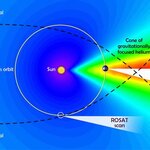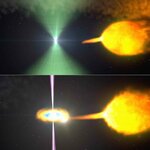Space

Io, the innermost of Jupiter's four large "Galilean" moons, is about the same size as Earth's moon, some 2,300 miles across, but it is very different than our moon. So different it is the only other place in the solar system that shares one trait that Earth has - volcanoes erupting extremely hot lava.
Because of Io's low gravity, large volcanic eruptions produce an umbrella of debris that rises high into space and that can be seen from Earth. Last August, astronomers did just that, capturing three massive volcanic eruptions within a two-week period.
It may be that these rare "outbursts",…

Scientists have recently gathered some of the strongest evidence to date to explain what makes the sun's outer atmosphere so much hotter than its surface. The new observations of the small-scale extremely hot temperatures are consistent with only one current theory - nanoflares – a constant peppering of impulsive bursts of heating, none of which can be individually detected, provide the mysterious extra heat.
What’s even more surprising is these new observations come from just six minutes worth of data from one of NASA's least expensive type of missions, a sounding rocket. The Extreme…

Astronomers using NASA's Hubble Space Telescope have unexpectedly discovered the most distant galaxy that acts as a cosmic magnifying glass. Seen here as it looked 9.6 billion years ago, this monster elliptical galaxy breaks the previous record-holder by 200 million years.
These "lensing" galaxies are so massive that their gravity bends, magnifies, and distorts light from objects behind it, a phenomenon called gravitational lensing. Finding one in such a small area of the sky is so rare that you would normally have to survey a region hundreds of times larger to find just one.
The object…

Observations by NASA's Fermi Gamma-ray Space Telescope of several stellar eruptions, called novae, firmly establish these relatively common outbursts almost always produce gamma rays, the most energetic form of light.
"There's a saying that one is a fluke, two is a coincidence, and three is a class, and we're now at four novae and counting with Fermi," said Teddy Cheung, an astrophysicist at the Naval Research Laboratory in Washington, and the lead author of a paper reporting the findings in the Aug. 1 edition of the journal Science.
A nova is a sudden, short-lived brightening of an otherwise…

Does this galaxy make me look fat? Has Andromeda been taking skinny selfies?
It turns out the way some astrophysicists have been studying our galaxy made it appear that the Milky Way might be more massive than it's neighbor Andromeda.
It isn't, says a study published in the journal Monthly Notices of the Royal Astronomical Society by an international group of researchers, including Matthew Walker of Carnegie Mellon University's McWilliams Center for Cosmology. In the paper, they outline a new, more accurate method for measuring the mass of galaxies. Using this method, the researchers…

New findings have resolved a decades-old puzzle about a fog of low-energy X-rays observed over the entire sky. Thanks to refurbished detectors first flown on a NASA sounding rocket in the 1970s, astronomers have now confirmed the long-held suspicion that much of this glow stems from a region of million-degree interstellar plasma known as the local hot bubble, or LHB.
At the same time, the study also establishes upper limits on the amount of low-energy, or soft, X-rays produced within our planetary system by the solar wind, a gusty outflow of charged particles emanating from the sun.…

I thought I'd post this, because, though it is obvious to most people in the field - there are many who still think that present day life on the surface of Mars is impossible because of UV light, ionizing radiation, perchlorates, and the atmosphere in equilibrium.
It's particularly topical right now because of this news story that has broken recently, about a discovery of a new way of creating habitats with liquid water on Mars on the interface between salts and ice
The professor says
""Based on the results of our experiment, we expect this soft ice that can liquify perhaps…

In June of 2013, an exceptional binary containing a rapidly spinning neutron star underwent a dramatic change in behavior never before observed - the pulsar radio beacon vanished and the system brightened fivefold in gamma rays, the most powerful form of light.
A binary consists of two stars orbiting around their common center of mass. This system, known as AY Sextantis, is located about 4,400 light-years away in the constellation Sextans. It pairs a 1.7-millisecond pulsar named PSR J1023+0038 -- J1023 for short -- with a star containing about one-fifth the mass of the sun. The stars complete…

Kepler-421b
has been revealed as a transiting exoplanet with the longest known year - 704 days. For comparison, Mars orbits our Sun once every 780 days.
The farther a planet is from its star, the less likely it is to transit the star from Earth's point of view. It has to line up just right, and most of the 1,800-plus exoplanets discovered so far are much closer to their stars and have much shorter orbital periods. The host star, Kepler-421, is located about 1,000 light-years from Earth in the direction of the constellation Lyra.
Kepler-421b orbits an orange, type K star…

A new discovery that many small galaxies throughout the universe do not 'swarm' around larger ones like bees but instead 'dance' in orderly disc-shaped orbits is a challenge to our understanding of how the universe formed and evolved.
The universe contains billions of galaxies. Some, such as the Milky Way, are immense, containing hundreds of billions of stars. Most galaxies, however, are dwarfs, much smaller and with only a few billion stars.
For decades astronomers have used computer models to predict how these dwarf galaxies should orbit large galaxies. They had always found…